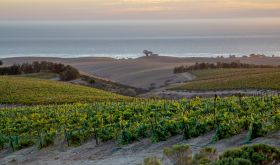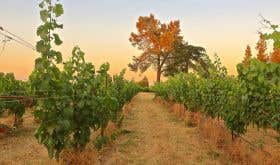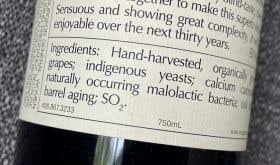A quote by grower Andy Beckstoffer graces the inside cover of a coffee-table book of photographs entitled Cabernet: A Photographic Journey from Vine to Wine by photographer Charles O’Rear. 'Cabernet is royalty!’ it reads. ‘She is noble, she is powerful, voluptuous, and a profit to all the senses.’
Beckstoffer owns 89 acres (36 ha) of the historical To Kalon vineyard and, since he raised his grape prices again last year, some people have started to grumble about just how much profit might actually be involved.
The To Kalon vineyard was planted by Henry W Crabb in the late 1860s, and named for the Greek to kalon ‘the beautiful'. Once spanning more than 359 acres (145 ha) and containing more than 400 different grape varieties thanks to the nurseryman’s obsessive experimentation, pieces of To Kalon changed hands many times after Crabb’s death in 1899. Today the pieces of that historic vineyard are in the hands of three primary owners: Robert Mondavi Winery, Opus One (the joint venture between Robert Mondavi and the owners of Ch Mouton Rothschild), and grower Andy Beckstoffer.
Until the year 2000, no wines other than those produced by Mondavi were allowed to carry the To Kalon name. But in the settlement of a lawsuit over Schrader Vineyard’s use of the name on their label (having purchased fruit from Beckstoffer), Beckstoffer (and by extension, those producers who buy from him) was granted a perpetual royalty-free licence to use the To Kalon name.
Since then, the three words Beckstoffer To Kalon have graced some of the highest-rated and most expensive bottles of wine made in Napa. Names such as Schrader, Paul Hobbs, Tor Kenward Family Wines, Realm Cellars, Provenance, Alpha Omega, and Morlet Family Vineyards have all bottled vineyard-designated wines from Beckstoffer To Kalon.
In the October 2014 issue of Robert Parker’s The Wine Advocate no fewer than four wines from the vineyard scored the coveted 100-point rating, with dozens more scoring well above 95 points.
Beckstoffer, who makes no wine himself, uses a very particular pricing model for his To Kalon grapes. His contracts with customers specify three pricing scenarios for the grapes: a fixed price per ton, a fixed price per acre, and a fixed multiplier of the winery’s suggested retail price per bottle, with a required minimum bottle price. The per-acre price acts as an insurance policy in the event of a winemaker’s deciding to restrict yields to unusually low levels. For the most part, winemakers simply pay the higher of the other two prices.
Last year, Beckstoffer invited every one of his customers to his office for a conversation in which he explained carefully that he was not going to be renewing any grape-purchasing contracts. Instead he would be raising his prices, and offering the opportunity to begin entirely new contracts following the expiration of the current ones.
His new prices, he announced, would be as follows: either $18,000 per ton or 175 times the bottle price per ton whichever was higher, with a minimum of $45,000 per acre as insurance against aggressive yield reduction. The minimum price that anyone could charge for a bottle with Beckstoffer To Kalon on the label would be $125 (the Mondavi version from their property currently retails at $145/£98/€137).
Do some quick maths, and you quickly realise that someone selling a bottle of Beckstoffer To Kalon Cabernet Sauvignon for US $150 (one of the lowest prices for such a bottle you’ll find) will soon be paying US $26,250 per ton of grapes, while the top producers, whose 100-point wines sell for US $300 or more, will be paying more than US $50,000 per ton of grapes.
Prior to this latest price rise, most customers were paying 100 times their bottle price per ton, and for some the jump to a multiple of 175, even with a couple of years’ warning, was a lot to stomach.
‘I can't blame him for asking, I’m just curious to see how many will pay it and for how long', wrote one winemaker who has been making a To Kalon bottling for many years. ‘I know one or two people who were outraged.’
As you may imagine, every winemaker or winery owner who spoke to me for this report wanted to remain anonymous. Several suggested that they knew at least one customer who had decided not to continue buying, and another I spoke to indicated they were likely to stop once their existing contract ran out.
‘I don’t know yet what we will do [when our contract expires]', said one, ‘Will I swallow it? I will try to negotiate, as this is a steep increase. It’s a real debate I am having right now.’
‘Is it fair?’ he continued, ‘I don’t know. It is an amazing site. It is the most well-known vineyard in Napa. The To Kalon brand is so big and so recognised, I’m not so sure how smart it is to let it go.’
Considering To Kalon as a brand proves unusually helpful in thinking through the incredible prices it is able to command. How is it that people are willing to pay $50,000 for a ton of Beckstoffer To Kalon fruit, when the average price for a ton of high-quality Napa Cabernet Sauvignon on the open market was $5,800 in 2014 according to Ciatti, the global wine and grape brokerage that handles the sale of much of Napa’s excess fruit and wine?
‘In some cases, the name of the vineyard is much better known than the winery', says Beckstoffer. ‘We’re not just a grower anymore, we’re selling a branded product.’
We can think about a brand as a name into which we project a personality and a set of values. But the most valuable brands in the world have achieved and keep their stature because they ultimately deliver to their customers the things that they symbolically represent.
And this is precisely the point that Beckstoffer will make in the context of explaining why his fruit is more expensive than anyone else’s in the valley, a fact for which he feels no need to apologise.
‘Up until 20 years ago, the best wines made in Napa were almost always designated as Reserve wines', says Beckstoffer. ‘That was the era of the magic chef. The winemaker said “bring me whatever you want from the vineyards”, and then the winemaker did his magic, and that is how you got a higher quality wine.’
‘But then we asked ourselves, how could we raise the quality of the wines', continues Beckstoffer, speaking for the collective community of Napa growers and winemakers. ‘We decided to focus on vineyard designates. We found the great sites, we raised the quality of the terroir and we showed off that terroir.’
‘The Reserve wines were creations, something like Barbie Dolls™. If you had a problem with any grapes you added a little shoulder here, a little breast there until you had something approaching great. The vineyard-designate is something else. It’s a beauty with a chipped tooth. You see every imperfection as it is. It’s a new world of wine quality that we’re in, and if what everyone says is true, that the wine is made in the vineyard, then the vineyard is where that quality comes from and the grower should share in the profitability that comes from that quality.’
‘We’re used to paying based on the quality of the ingredients', suggests Beckstoffer, ‘especially when it comes to food and where it was grown. Translate that to wine and you get higher prices for Napa grapes than for elsewhere, and you get yet higher prices for individual vineyards. But you have to prove that quality.’
As far as Beckstoffer is concerned, the scores from all the major critics are all the proof he needs for what his To Kalon vineyard can deliver in terms of quality.
As steep as his prices might be for that quality, they are far from arbitrary, however. In fact, they are rooted in what Beckstoffer claims is a set of historical norms. According to him, as far back as the 1970s, in an effort to get themselves out of purely commodity-based pricing, better-quality grape growers in Napa began successfully to argue for what he calls a bottle-price formula that tied the price of grapes to the sale price of the wine.
Enlisting the help of, among others, the consulting firm Price Waterhouse Coopers, Beckstoffer established that on average, the historical cost of grapes (inclusive of all the labour and materials involved in growing them) for most premium wineries came to about 26% of the final wholesale bottle price to the market, which was how most wineries sold their wine. With somewhere between 65 to 75 cases of wine made per ton of grapes, Beckstoffer’s calculations have that amount ending up somewhere around 100 times the bottle price per ton.
Indeed, even today, if you figure that the average price of a Napa-designated Cabernet Sauvignon is around $50 per bottle, at a bulk price of $5,900 per ton, the 100 to 1 ratio holds up pretty well, even 30 or 40 years later.
But something very important has changed over those decades. Not only have the prices for top-quality Napa Cabernets sky-rocketed, thanks in no small measure to their critical acclaim, but the proportion of those top wines sold almost entirely direct to the consumer has also sky-rocketed.
That change alone means to Beckstoffer that as a measure of their overall profit per bottle, the cost of grapes has gone from 26% of a winery’s total revenue to at least half of that amount. And when it comes to his grapes, he thinks that he is entitled to his fair share of the pie.
‘Look at it this way', he says. ‘If you are a winery and you’re charging $350 for a bottle of To Kalon Cabernet, and you’re making roughly 55 cases per ton of grapes (an average that Beckstoffer says holds up pretty well among his clients), your revenue on that wine is $231,000 per ton of grapes you buy from me. I’m not telling you whether to charge $350 a bottle, I’m just asking for my share.’
At his current pricing of 175 times the bottle price, Beckstoffer’s share would be exactly 26.5% of that $231,000.
The Beckstoffer customers who will be most keenly challenged by this new pricing scheme will be those who do not sell mainly direct to consumers at full retail prices.
‘If you’re buying Andy’s grapes at 175 times the bottle price and your business plan is selling mostly through wholesalers, that’s a pretty rough business', says one winemaker I talked with. ‘You’re almost certainly losing money. To get in and work with grapes that expensive you have to look at your business model and know what you’re willing to lose, or just how much you have to sell directly to the consumer in order to make it work.’
‘I’ve talked with some of the other people who are buying To Kalon fruit', said one frustrated winemaker, ‘and the winery principal said “yeah, we know we can’t make any money on this, but we have customers who have come to expect the wine, so we need to keep making it.’’
‘Do you know how they’re going to keep doing it?’ continued this winemaker, ‘They’re taking money out of their marketing budget to pay for the grapes.’
Regardless of their feelings about this most recent price rise, every winemaker I spoke with had nothing but praise for Beckstoffer, both as a grower and as a businessman. Even those whose reactions approached outrage begrudgingly admitted that as the owner of an incredibly scarce resource, Beckstoffer was ultimately justified in charging whatever he thought the market could bear for his grapes.
‘Are the prices too high?’ mused one winemaker. ‘Andy is no dummy. He knows he can only push so much. But we’re not there yet. There’s a lot of money coming into the valley right now. There’s enough money in China that Andy could sell every last grape to the Chinese if he wanted to, at whatever prices he wanted.’













